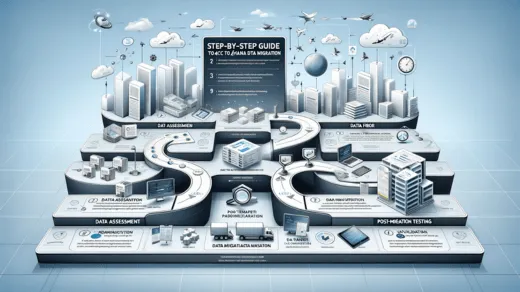Step-by-Step Guide to ECC to S/4HANA Data Migration

In today’s rapidly evolving digital landscape, businesses are continually looking for ways to streamline their operations and stay competitive. One crucial aspect of this transformation is migrating data from SAP ECC (Enterprise Central Component) to S/4HANA, SAP’s next-generation ERP suite. This transition is more than just a technical shift; it’s a strategic move that can redefine how a company operates. In this comprehensive guide, we will take you through the step-by-step process of ECC to S/4HANA Data Migration, ensuring that your organization can make a smooth transition without any hiccups.
Understanding the Importance of ECC to S/4HANA Migration
Before we delve into the details, let’s grasp the significance of migrating from ECC to S/4HANA. SAP S/4HANA offers advanced functionalities and a streamlined user experience compared to ECC. It leverages in-memory computing, providing real-time data analytics and insights. This migration is essential for organizations seeking:
- Enhanced Efficiency: S/4HANA simplifies processes, eliminates redundancies, and accelerates decision-making, ultimately boosting operational efficiency.
- Competitive Advantage: Staying up-to-date with SAP’s latest technology ensures that your business remains competitive in the market.
- Future-Proofing: ECC’s support will end in 2027. By migrating to S/4HANA, you future-proof your business and ensure ongoing support and updates from SAP.
Planning Your ECC to S/4HANA Data Migration
Successful data migration requires meticulous planning. Here are the key steps you should follow:
1. Assessment and Readiness Analysis
- Begin by assessing your current ECC system’s landscape and data structure.
- Identify customizations, extensions, and third-party integrations.
- Evaluate your hardware and infrastructure for S/4HANA compatibility.
- Establish a clear migration strategy, including goals, timelines, and budget considerations.
2. Data Cleansing and Preparation
- Cleanse and consolidate your data, removing duplicates and obsolete records.
- Ensure data integrity and accuracy.
- Map ECC data objects to their corresponding S/4HANA structures.
- Define data archiving and retention policies.
3. Custom Code Adaptation
- Review custom ABAP code and adapt it to S/4HANA requirements.
- Replace deprecated functions and adapt to new data models.
- Test and validate custom code changes thoroughly.
4. System Conversion or New Implementation
- Decide between system conversion (upgrading your existing ECC system to S/4HANA) or a new implementation (building S/4HANA from scratch).
- Choose the approach that aligns with your organization’s goals and constraints.
5. Testing and Validation
- Perform extensive testing to ensure data consistency and system functionality.
- Conduct user acceptance testing (UAT) involving key stakeholders.
- Address and rectify any issues that arise during testing.
6. Training and Change Management
- Train your staff to adapt to the new S/4HANA environment.
- Develop change management strategies to minimize disruption during the migration.
- Communicate changes and expectations clearly to all employees.
7. Go-Live and Post-Migration Support
- Execute the migration during a planned downtime window.
- Monitor the system closely after go-live to address any immediate issues.
- Provide ongoing support and fine-tuning as needed.
Ensuring a Smooth Transition
The success of your ECC to S/4HANA data migration depends on careful planning and execution. It’s crucial to work with experienced SAP consultants and a dedicated project team to oversee the process. Additionally, consider the following best practices:
- Regularly update your project plan and communicate progress to stakeholders.
- Establish data backup and disaster recovery procedures.
- Create comprehensive documentation for future reference.
- Monitor system performance post-migration and optimize as required.
Conclusion
Migrating from SAP ECC to S/4HANA is a significant undertaking, but it’s a crucial step for organizations aiming to thrive in the digital era. By following this step-by-step guide, you can ensure a seamless transition that maximizes the benefits of S/4HANA while minimizing disruptions to your business operations. Remember, successful data migration is not just about technology—it’s about strategic planning and meticulous execution.




